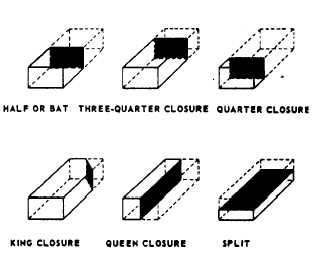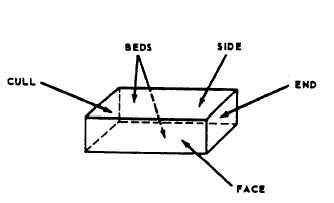Brick Nomenclature
Frequently, the Builder must cut the brick
into various shapes. The most common shapes are
shown in figure 7-50. They are called half or bat,
three-quarter closure, quarter closure, king
closure, queen closure, and split. They are used
to fill in the spaces at corners and such other
places where a full brick will not fit.
The six surfaces of a brick are called the cull,
the beds, the side, the end, and the face, as shown
in figure 7-51.
Brick Classification
A finished brick structure contains FACE
brick (brick placed on the exposed face of the
structure) and BACKUP brick (brick placed
behind the face brick). The face brick is often of
higher quality than the backup brick; however,
the entire wall may be built of COMMON brick.
Figure 7-50.-Nomenclature of common shapes of cut brick.
Figure 7-51.-Brick surfaces nomenclature.
Common brick is brick that is made from pit-run
clay, with no attempt at color control and
no special surface treatment like glazing or
enameling. Most common brick is red.
Although any surface brick is a face brick as
distinguished from a backup brick, the term face
brick is also used to distinguish high-quality brick
from brick that is of common-brick quality or
less. Applying this criterion, face brick is more
uniform in color than common brick, and it may
be obtained in a variety of colors as well. It may
be specifically finished on the surface, and in any
case, it has a better surface appearance than
common brick. It may also be more durable, as
a result of the use of select clay and other
materials, or as a result of special manu-
facturing methods.
Backup brick may consist of brick that is
inferior in quality even to common brick. Brick
that has been underburned or overburned, or
brick made with inferior clay or by inferior
methods, is often used for backup brick.
Still another type of classification divides brick
into grades according to the probable climatic
conditions to which it is to be exposed. These are
as follows:
GRADE SW is brick designed to withstand
exposure to below-freezing temperatures in a
moist climate like that of the northern regions of
the United States.
GRADE MW is brick designed to withstand
exposure to below-freezing temperatures in a drier
climate than that mentioned in the previous
paragraph.
GRADE NW is brick primarily intended for
interior or backup brick. It maybe used exposed,
however, in a region where no frost action occurs,
or in a region where frost action occurs, but the
annual rainfall is less than 15 in.
Types of Bricks
There are many types of brick. Some are
different in formation and composition while
others vary according to their use. Some
commonly used types of brick are described in the
following paragraphs.
COMMON brick is made of ordinary clays or
shales and burned in the usual manner in the
7-31




